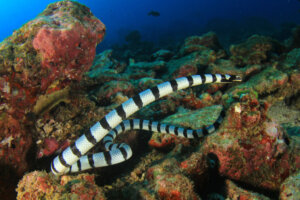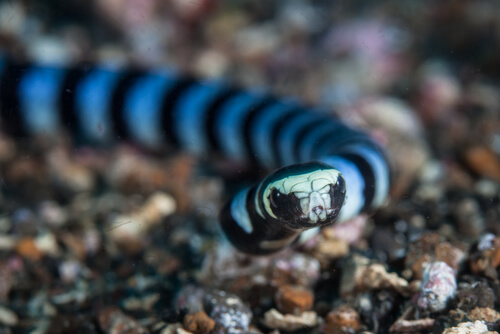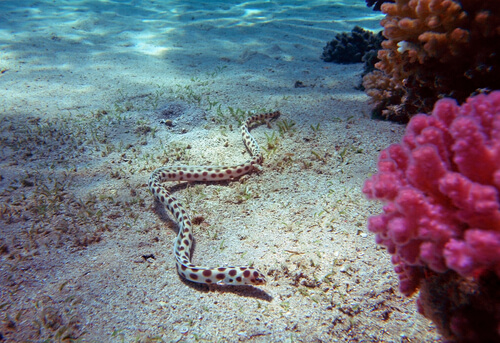5 Curiosities About the Sea Serpent and Sea Snake

Here are 5 curiosities about the sea snake that will help you understand why this reptile has aroused such interest throughout the history of mankind. The myth (about the sea serpent in this case) that originated from popular stories has left an open door to explain some of the hidden realities about this animal. Don’t miss this fascinating article.
Fascinating curiosities about the sea serpent and sea snake

Throughout time, mythological stories, legends, and popular beliefs have created a number of curiosities surrounding the sea snake.
You only have to read the testimonies from March 1994 on the Arenas Verdes site, for example, to realize the mysteries surrounding the sightings of this kind of reptile, most of the time mistaken for monsters inhabiting lakes, seas, oceans, and other waters.
“More than thirty people reportedly observed an animal with a turtle head supported by a very long swan-like neck and dinosaur-like flippers along its length”. For other witnesses, it would be an animal with “an enormous back…. about three meters long. Its skin was like that of a crocodile, and the top was like a saw of triangles along its entire length”.
-Morrone, Juan José (1994).
So, without further ado, we bring you 5 curiosities and surprising facts about the sea snake that will fascinate you!
1. The sea snake, or “serpent” doesn’t have to be a snake, nor does it have to be the same species
In mythology, any long sea monster shaped like a snake or eel doesn’t necessarily need to be related to a snake; it can also have several different aspects.
Some have reported sightings of elongated, serpentine creatures in seas, oceans, lakes, etc. And sometimes these are sightings made by several different observers.
2. The confusion of animals caused by the “sea serpent”
The myth that has given rise to the “sea serpent” may have originated from several animals. Among them, the following should be expressly mentioned:
- Oarfish: With its 11 meters (36 feet) in length, it has been confused many times with sea snakes, or serpents.
- Basilosaurus Hydrophiinae: When the first fossils of this extinct cetacean were found, it was believed that they belonged to a gigantic marine reptile of 40 meters (130 feet) or more.
- Eagles or other snake-like animals.
- True sea snakes, adapted to aquatic life, whose size may have been exaggerated.
3. An animal described since antiquity
Fantastic stories have been written revolving around the so-called “sea serpents”. For example, the Caicai Vilu (from Mapuche mythology), the Loch Ness Monster, Tiamat (goddess from Babylonian mythology), among others. In this sense, a slithering serpent is also described in the biblical account of the Leviathan.
“In that day the LORD, with his hard and great and strong sword, will direct his attention to Leviathan, the slithering serpent, even to Leviathan, the crooked serpent, and he will surely slay the sea monster that is in the sea.”
The 17th century is when most of the sightings on the New England Coast were documented, as evidenced by a study published in 1920 by the American Society of Ichthyologists and Herpetologists (ASIH). A large black snake with a diseased spine was even given the scientific name Scoliophis atlanticus.
The reality behind the myth
Over time, the sea snake has been categorized into a subfamily of venomous snakes within the family Elapidae. Although they evolved from their terrestrial ancestors, the vast majority are unable to survive out of the water, although the exception is the Laticauda species, which retain some of these ancestral characteristics that allow them to move on land, as supported by research carried out by the University of Sydney.
In line with the previous curiosities, mythological and sighted by humans, two characteristics stand out that also explain their mythification and fascination for humans.
4. Venom and aggressiveness
This species of reptiles have been cataloged as very venomous snakes. Although they don’t usually attack unless they feel threatened, their aggressiveness increases during the mating period, and the venom of a sea snake is 2 to 10 times more potent than that of a cobra.
In this regard, the most venomous species listed is Enhydrina schistosa, which is also popularly known as the hook-nosed sea snake. Its neurotoxin content causes drowsiness, respiratory paralysis, and blurred vision.
5. Their reproduction is an exception in their species
With the exception of the Laticauda species, all other sea snakes are ovoviviparous. That is, the young are born alive in the water in groups of 2 to 9 (with rare exceptions of more than 30, including large specimens).
On the other hand, Laticauda species are oviparous and lay 1 to 10 eggs on land. They usually choose caves or rocky crevices for this purpose.
The curiosities of the sea serpent or sea snake and their ancestral and mythological origin

We hope that all these facts and curiosities have captivated you as much as the sea serpent did for settlers, sailors, and other people from different places and times. As you’ll have seen, these have awakened the interest of human beings throughout history.
That’s why such great stories have been told that revolve around this animal often spotted in aquatic areas. And, with the passing of time, the Lacicauda species has been given this scientific name.
Here are 5 curiosities about the sea snake that will help you understand why this reptile has aroused such interest throughout the history of mankind. The myth (about the sea serpent in this case) that originated from popular stories has left an open door to explain some of the hidden realities about this animal. Don’t miss this fascinating article.
Fascinating curiosities about the sea serpent and sea snake

Throughout time, mythological stories, legends, and popular beliefs have created a number of curiosities surrounding the sea snake.
You only have to read the testimonies from March 1994 on the Arenas Verdes site, for example, to realize the mysteries surrounding the sightings of this kind of reptile, most of the time mistaken for monsters inhabiting lakes, seas, oceans, and other waters.
“More than thirty people reportedly observed an animal with a turtle head supported by a very long swan-like neck and dinosaur-like flippers along its length”. For other witnesses, it would be an animal with “an enormous back…. about three meters long. Its skin was like that of a crocodile, and the top was like a saw of triangles along its entire length”.
-Morrone, Juan José (1994).
So, without further ado, we bring you 5 curiosities and surprising facts about the sea snake that will fascinate you!
1. The sea snake, or “serpent” doesn’t have to be a snake, nor does it have to be the same species
In mythology, any long sea monster shaped like a snake or eel doesn’t necessarily need to be related to a snake; it can also have several different aspects.
Some have reported sightings of elongated, serpentine creatures in seas, oceans, lakes, etc. And sometimes these are sightings made by several different observers.
2. The confusion of animals caused by the “sea serpent”
The myth that has given rise to the “sea serpent” may have originated from several animals. Among them, the following should be expressly mentioned:
- Oarfish: With its 11 meters (36 feet) in length, it has been confused many times with sea snakes, or serpents.
- Basilosaurus Hydrophiinae: When the first fossils of this extinct cetacean were found, it was believed that they belonged to a gigantic marine reptile of 40 meters (130 feet) or more.
- Eagles or other snake-like animals.
- True sea snakes, adapted to aquatic life, whose size may have been exaggerated.
3. An animal described since antiquity
Fantastic stories have been written revolving around the so-called “sea serpents”. For example, the Caicai Vilu (from Mapuche mythology), the Loch Ness Monster, Tiamat (goddess from Babylonian mythology), among others. In this sense, a slithering serpent is also described in the biblical account of the Leviathan.
“In that day the LORD, with his hard and great and strong sword, will direct his attention to Leviathan, the slithering serpent, even to Leviathan, the crooked serpent, and he will surely slay the sea monster that is in the sea.”
The 17th century is when most of the sightings on the New England Coast were documented, as evidenced by a study published in 1920 by the American Society of Ichthyologists and Herpetologists (ASIH). A large black snake with a diseased spine was even given the scientific name Scoliophis atlanticus.
The reality behind the myth
Over time, the sea snake has been categorized into a subfamily of venomous snakes within the family Elapidae. Although they evolved from their terrestrial ancestors, the vast majority are unable to survive out of the water, although the exception is the Laticauda species, which retain some of these ancestral characteristics that allow them to move on land, as supported by research carried out by the University of Sydney.
In line with the previous curiosities, mythological and sighted by humans, two characteristics stand out that also explain their mythification and fascination for humans.
4. Venom and aggressiveness
This species of reptiles have been cataloged as very venomous snakes. Although they don’t usually attack unless they feel threatened, their aggressiveness increases during the mating period, and the venom of a sea snake is 2 to 10 times more potent than that of a cobra.
In this regard, the most venomous species listed is Enhydrina schistosa, which is also popularly known as the hook-nosed sea snake. Its neurotoxin content causes drowsiness, respiratory paralysis, and blurred vision.
5. Their reproduction is an exception in their species
With the exception of the Laticauda species, all other sea snakes are ovoviviparous. That is, the young are born alive in the water in groups of 2 to 9 (with rare exceptions of more than 30, including large specimens).
On the other hand, Laticauda species are oviparous and lay 1 to 10 eggs on land. They usually choose caves or rocky crevices for this purpose.
The curiosities of the sea serpent or sea snake and their ancestral and mythological origin

We hope that all these facts and curiosities have captivated you as much as the sea serpent did for settlers, sailors, and other people from different places and times. As you’ll have seen, these have awakened the interest of human beings throughout history.
That’s why such great stories have been told that revolve around this animal often spotted in aquatic areas. And, with the passing of time, the Lacicauda species has been given this scientific name.
All cited sources were thoroughly reviewed by our team to ensure their quality, reliability, currency, and validity. The bibliography of this article was considered reliable and of academic or scientific accuracy.
- Archive.org. Retrieved October 23, 2022, from https://web.archive.org/web/20140911084747/https://www.msdsalud.es/manual-merck-hogar/seccion-2/mordeduras-picaduras-venenosas.html
- Babcock, H. L. (1920). Some reptile records from New England. Copeia, 85, 73. https://doi.org/10.2307/1437007
- Bibliatodo.com. Retrieved October 23, 2022, from https://www.bibliatodo.com/la-biblia/Nuevo-mundo-testigos-de-jehova/isaias-27
- Morrone, J. J. (1994). De serpientes marinas y otros monstruos. Museo, no. 3. http://sedici.unlp.edu.ar/handle/10915/47182
- Shine, R., & Shetty, S. (2001). Moving in two worlds: aquatic and terrestrial locomotion in sea snakes (Laticauda colubrina, Laticaudidae): Sea snake locomotion. Journal of Evolutionary Biology, 14(2), 338–346. https://doi.org/10.1046/j.1420-9101.2001.00265.x
This text is provided for informational purposes only and does not replace consultation with a professional. If in doubt, consult your specialist.








